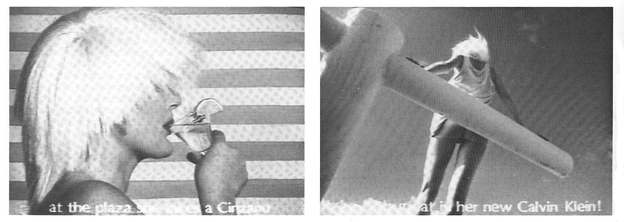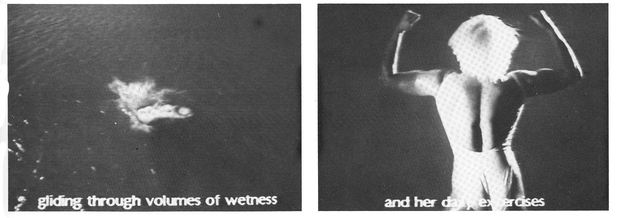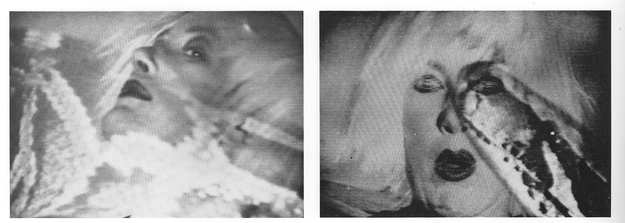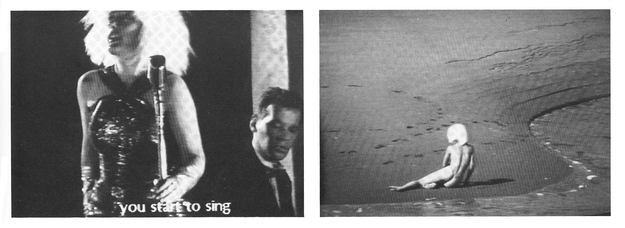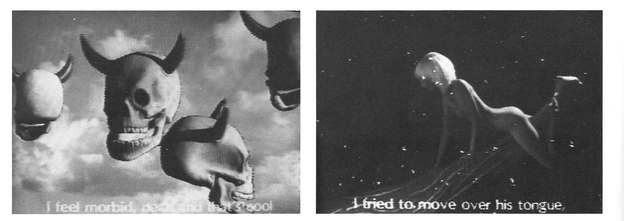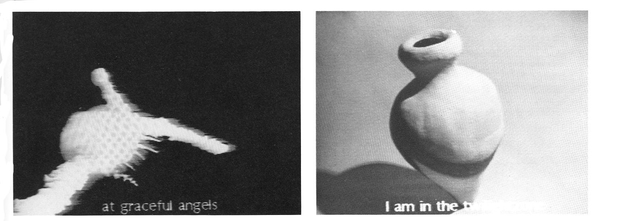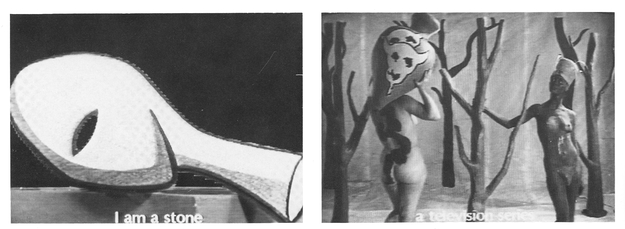SCHOUTEN and PERRéE quote that story because for them it's such a beautiful description of how the mass media can turn someone into a hero.
Apart from being a parable about the media, Being There can also be interpreted as a parable about media art: a person who has nothing to say about the world about him borrows texts from television, influential people see profound meanings in these texts. After some time, our gardener is even invited to perform on television. Nothing can stop his career as a hero.
The comparison is quite adequate. For example, in the case of LYDIA SCHOUTEN herself: SCHOUTEN's subject matter is borrowed from the media - and her own experience of it. Both her artistic idiom and grammar come from films, TV and advertising. Her last tape was commissioned by Dutch television. Following MELINA MERCOURI's example, she should at least make it to Minister of Culture.
And indeed, however strange it may sound, that story is very analogous to the image certain critics give media art. An obvious example is the article of JOUKE KLEEREBEZEM wrote for this magazine: ... For this purpose one draws on the media and art history. The images acquired in this way, which often suffer from inflated significance, are reproduced in a new structure. This process serves not only to prove lack of significance but also to propagate rather than criticize it. There is a latent but compelling need for significance at the root of this attitude: the need for actual emotions, for a consciousness that places itself in a framework of moral absolutisms. Out of impotence, the opposite extreme is propagated through fear of this need and the awareness of its dangerous consequences.2)
Hence the media artist is not mentally defective, he/she is simply emotionally and morally impotent. The artist quotes or emulates images from the media to avoid a confrontation with this impotence. What evil intent!
In a more recent article, in BEELD magazine, KLEEREBEZEM extends his argument to art that refers to popular culture (and thereby, according to JK, also threatens to degenerate into popular culture). 3)
In his crusade against frivolous contact with possible signifiers, he cites the GRONINGEN MUSEUM as the awful example ... each educational mimeograph from the GRONINGEN MUSEUM mentions pinball machines, comic strips, break dancing, record sleeves, new wave discos and the pleasure of watching an average evening's television. He puts the museum put on a par with a couple of amusements parks, this is followed by an impassioned plea for a more authentic content, message and engagement in art. 3)
Now that KLEEREBEZEM has extended his argument to the whole of visual art, it becomes really clear how his objections are concerned not with the use of the electronic media but with the blurring, fragmentation and popularization associated without any obligation with these media.
In addition, art may not reflect critically on any of these aspects: This vision (the content of the art work WV) is not meant to disseminate the authoritarian concept of the individual as victim of complexity but to point to the profusion of forms of existence and our coming together. Down with the gardeners!
I think that KLEEREBEZEM's objections don't apply to most of media art: However, there's no escape for SCHOUTEN's work: it clearly reflects the media, she made her last tape for television and on top of everything it was premièred in the GRONINGEN MUSEUM.
In the same magazine, REIN WOLFS wrote an article about LYDIA SCHOUTEN and ROB SCHOLTE.4) According to WOLFS, SCHOUTEN's work is too insubstantial, her statements are not clear enough. He observes that she parodies all kind of codes and is deeply involved with the ambivalent position of the artist/consumer. However this is only relativization and relativization has no significance in this world where everything is relative(!): LYDIA SCHOUTEN's work becomes safer all the time and takes more and more the form of a fairy tale: it presents a truth which keeps its validity until - in the best case - the last line of the story. Flattery, flattery!
In this context, it's interesting that SCHOUTEN's last tape was commissioned by Dutch television. Not by the VPRO, the broadcasting corporation that provides the freischwebende Intelligenz in the Netherlands with its weekly helping of leftish-liberal viewing fodder (currently with added video art vitamins). Nor by VERONICA that offers youth the horniest violence. But by the HUMANIST ASSOCIATION, a small broadcasting permit holder. An ideological organization whose objectives5) coincide almost completely with JOUKE KLEEREBEZEM's ideas about the artist's responsibility (should he be a member?). Furthermore, an organization that has very little air time, which, furthermore, is not dependent on numbers of members or viewers so that it can remain calmly occupied with its moral issues.
The HUMANIST ASSOCIATION doesn't often broadcast video art. The last time was in 1982 with MICHEL CARDENA's Somos Libres!?, a tape about power, religion, oppression and homosexuality. The occasional attention to art (video), the organization's objectives and the subjects of these two tapes make one suspect that the choice of programs is made on the grounds of content.
How did they get it in their heads to hire someone who succumbs to a world of romantic escapism, someone who is willing to look for another world tomorrow and to swap the order of today for a new one?4) Someone who uses techniques of reproduction without, however, exploiting them to achieve circulation and give the work a broader range of distribution but only as proof of the possibility of making an image without deriving or attaching any significance from or to the original model? 3 Have they all gone completely NUTS at the HUMANIST ASSOCIATION?
Of course not, KLEEREBEZEM and WOLFS simply misjudge media art. An important cause of this is that their thinking is postmodern (also: French).
Postmodern thinking is a particularly enjoyable way of thinking which began to catch on in cultural philosophic circles in the Sixties. An import point of departure is: things are not what they seem. Of course, everyone knows that. However, the postmodern thinker seeks the very opposite behind it all. He likes to confront a phenomenon with its reverse and thus find a deeper significance that the reverse has in common with the original idea. This technique also works with larger numbers of concepts with more or less opposing significances.
This method is like shaking up a pillow: it loosens up the brain cells and gives them a delicious stimulus to take all kinds of different routes. This last aspect is what is both beautiful and dangerous about the whole approach. Confronting something with its opposite can make it just disappear. It is neutralized: Plus + Minus = Nil.
The awareness that things are not always what they seem can, in daily life, lead to caution and possibly to deeper insight. Art may even come out of that caution and insight. However, for the contemporary thinker that awareness can lead to just mere thoughts.
Now that is precisely what WOLFS and KLEEREBEZEM are against: the practice of the postmodern technique (in art). Because it leads to point zero.
The problem now is that they are too immersed in postmodern thinking (so as to be able to recognize its evil). They are constantly on the lookout that it doesn't break out somewhere or other.
Now, if an artist whose work is involved with the media tries to define her point of view in relation to the media and if this artist comes to somewhat ambiguous conclusions then KLEEREBEZEM's hair is going to stand on end and he will perceive inflation of meaning, the uncommitted accumulation of images that neutralize each other and fear of the need for actual emotions(!). The media artist is denied the possibility of an honest attitude. The artist shouldn't relate to the media, that hotbed of all that is wrong in this age.
The need for actual emotions. That is precisely SCHOUTEN's subject. She writes in the Infermental V catalogue: The media create an imaginary world which, contrary to what one would expect, is very personal. The existing world in which we live is in sharp contrast with it and is becoming increasingly drab and grey. The media show desires in a more and more subtle way while 'our' desires become more aggressive and remain unanswered. The 'old fashioned' pattern of falling in love, marrying and having children is no longer enough, the media have created unrest amongst Relaxation. I am in the twilight zonemodern people, through which one acquires a passion for the various codes supplied by the media.
A passion for the various codes supplied by the media has not been overlooked in the style of her work. It is precisely this passion that distinguishes her from KLEEREBEZEM, otherwise her argument could have been thought up by him. So you could suppose that KLEEREBEZEM and SCHOUTEN agree about the media. But where KLEEREBEZEM looks away filled with disgust, SCHOUTEN becomes fascinated and takes on the conflicts caused by the media and (through that) herself. She is looking for a way of relating who reality (the media exist and influence everybody).
KLEEREBEZEM, blinded by abhorrence for (media) idiom, can see nothing apart from inflation of meaning and deconstructivist lack of commitment. He projects his notion of postmodern thinking too hastily on the art he sees.
WOLFS is also against postmodern thinking: The method of reversal as a handy gimmick unfortunately all too easily skip the seriousness of the existing conflict which would be better served by searching for solutions. And shouldn't an attitude of self-criticism also play an important role in this process? 4)
In an alleged change6) in SCHOUTEN's work which was said to imply a reversal (!) of power relationships, WOLFS has found a parallel with the theory of BAUDRILLARD (French postmodern philosopher) which transfers power from the subject (desire) to the object (seduction). According to the statement quoted above, he dissaproves of this reversal and with the work on which he had previously projected it.
And if there really is talk of a reversal, it goes in the opposite direction: SCHOUTEN takes the seduction (the media) and uses it to research desire (herself). That seduction can spark off desire and that desire can reach out into the domain of seduction make the relation both dramatic and complicated. The subject is under fire and is defending itself. WOLFS and KLEEREBEZEM still only see fire.
The extent to which LYDIA SCHOUTEN's work is personal is shown by the fact that she always plays the leading role. A role which she has made the more dramatic in her last tape by using a gorgeous young girl as a stand-in for those scenes where her body is visible. A device which is executed perfectly in terms of editing technique. The drama become just noticable at the end when she 'blows it' a couple of times. Then people who don't know from her previous tapes that SCHOUTEN (1948) is rather more substantial in build, can also understand what it's about.
The problem with SCHOUTEN and with many other media artists is that the work looks too realistic. It is not hermetic enough and hence some passers-by are blinded by the first level of significance they come upon.
It is an old problem, even FLAUBERT was hauled in front of a judge in 1857 when he published a book about a farmer's daughter who falls victim to her desires. Desires which were stirred by the books the unfortunate woman had read during adolescence. As FLAUBERT said: Madame Bovary, c'est moi!
Lydia Schouten Forever Young/Echoes of Death 1986
The tape begins with a statement CATHERINE DENEUVE: CDN was born swimming. She is a cinematic foible (whatever that is). And about the video itsalf: it is not a story, the plot is an egg.
Sure enough, we then see a blond woman with LYDIA SCHOUTEN's face and the body of a stand-in half her age (her wig is something of a cross between DEBBIE HARY and ANDY WARHOL).
First, we get to know our star, her day-today worries - or, to put it more elegantly: her lifestyle. At the plaza she takes a Cinzano, she looks great in her new CALVIN KLEIN. Then, she concentrates on smoking a well-known brand of cigarettes and wearing designer jeans. To be beautiful, she does exercises everyday and takes vitamins.
Each aspect is represented by a brief shot, in the perfect styling of advertising photography. This style is employed throughout the video; visually extremely self-contained images, stately editing, scenes built up out of just a few takes, constant changes in style and the visual inclusion of lines of texts give the viewer the feeling of leafing through a fashion magazine.
There is a flash-back to a nightclub after a (rather filmic and very beautiful) transition from the road surface gliding past her sports car to a sensually writhing snake which is then relared to her face giving the girl curious shimmering eyes.
I was dancing last Wednesday. Despite the fact that everyone is splendidly decked out, the general mood seems somewhat lackluster. After dancing a little, she steps up on stage and sings, She utters nothing more than weary clichés about physical appearance: Körperliche Schönheit besitzen macht Eine reich und neidenswürdig (Possessing a beautiful body makes one rich and enviable).
End of the flash-back. Our heroine has now landed on a beach and lies down at the water's edge. She closes her eyes and an ominous-sounding funeral bell begins to strike. From this moment on, the rape becomes less easy to understand.
When I opened my eyes / I was in a cool dark room, with an insistent humming sound / my human body was divided into layers / like a warehouse of xerox beings / I looked Japanese, I could not think any longer.
The rest seems to be taking place in her mind. The surreal sequences of images which accompany her suicide (real or imagined) in the rising tide are more graphic and refer to visual art rather than to advertising. Finally, she experiences something real.
Her associations with death and sex vary from the crudest jokes: dangling skulls with little red horns - Donald Duck does voodoo, to the beautifully visualized reflections on the infinite: If I move through space / will there be ellipses and ghostly after-images, as I multiply in time?
She identifies herself with the American Space Shuttle which exploded last year and with CATHERINE DENEUVE.
After an erotic adventure with a sumo wrestler; Why am I so attracted to sexual dangerousness? - the sound of the bell turns into music.
Relaxation. I am in the twilight zone / I am at home / I am a stone / a television image / a television series. Is there life after death? Yes, on television. While I clone myself / I explode in silver waterfalls, and fall in a heavy sleep of death in which dreams might come to me ...
Forever Young/Echoes of Death is of 13 minutes duration. A home format copy of this tape is available through Mediamatic at the reduced price of ƒ 200,-. This copy is only to be used for private viewing. Copying, renting or public presentation would be illegal. Please use the reply card in this issue. For tapes with extended rights or Lydia Schouten's photographic works, please contact Torch Contemporary Pictures in Amsterdam, for tape rental: Time Based Arts, Amsterdam.
1) Bodeving, Perrée, Schouten Infermental 5, The Image of Fiction Con Rumore, Rotterdam 1986 ISBN 90 71641 01 5
2) Jouke Kleerebezem More Tales from the Beauty Farm, in Mediamatic vol.O no.O, Groningen 1985 ISSN 0920 7864
3) Jouke Kleerebezem Media-Wollen or Res Publica, in Beeld year 2 no.4, Amsterdam, February 1987. This article forms a mini-theme together with the quoted article from Rein Wolfs: Media Art: Acceptance or Dissociation. As the title already suggests, the article is actually not about media art but about art and media. It is remarkable how Kleerebezem, since his article in the zero issue of Mediamatic in which he unleashed his views about the artist's responsibilities, is now counted amongst the most important Dutch critics in this field. Like a sort of Archangel Gabriel, his sword has blazed forth at forum discussions, lectures, even on a NOS art program. And the editorial board of Bee&D also published his otherwise interesting supplement which appeared under the heading of Media Art. However he is not talking about that but about visual art or even Art in general.
4) Rein Wolfs Van Schouten tot Scholte, about media art in the Netherlands in Beeld jaar 2, no.4 Amsterdam 1987.
5) Taken from the statutes of the Humanist Association: humanism is a philosophy of life which tries to understand life and the world, exclusively by human means. It considers it essential that human beings have the capacity for making discerning judgments in which nothing or nobody else can be held responsible.Humanism is characterized by:
-1 The constant willingness to be held accountable for acting according to norms of reason in thoughts and deeds.
-2 A helping concern for one's fellow man to enable him to develop a valuable existence and purpose.
-3 The striving for a society which revolves around freedom, justice, tolerance, respect for human dignity and solidarity.
The Humanist Association aims:
-1 To unite all those who agree with these principles.
-2 To be a center for the deepening, propagation and defense of the humanist philosophy of life.
-3 To develop activities and participate in the activities of others who contribute to the creation of a society of people who are conscious of their responsibility for themselves, their fellow men, nature and society.
6) From Split Seconds of Magnificence (1984) onwards, the imaginary world in Schouten's work is, according to Wolfs no longer controlled by herself (playing the leading role) but by other forces. Even before she made video, other forces were a principle subject of her (feminist) performances. Her earlier tapes (e.g. The Lone Ranger lost in the Jungle of Erotic Desire, 1982) are also teeming with inner and outer forces and threats.
If you'd like to quote something: Velthoven, Willem. "Forever Young/Echoes of Death." Mediamatic Magazine vol. 1 # 4 (1987).
Translation: Annie Wright
